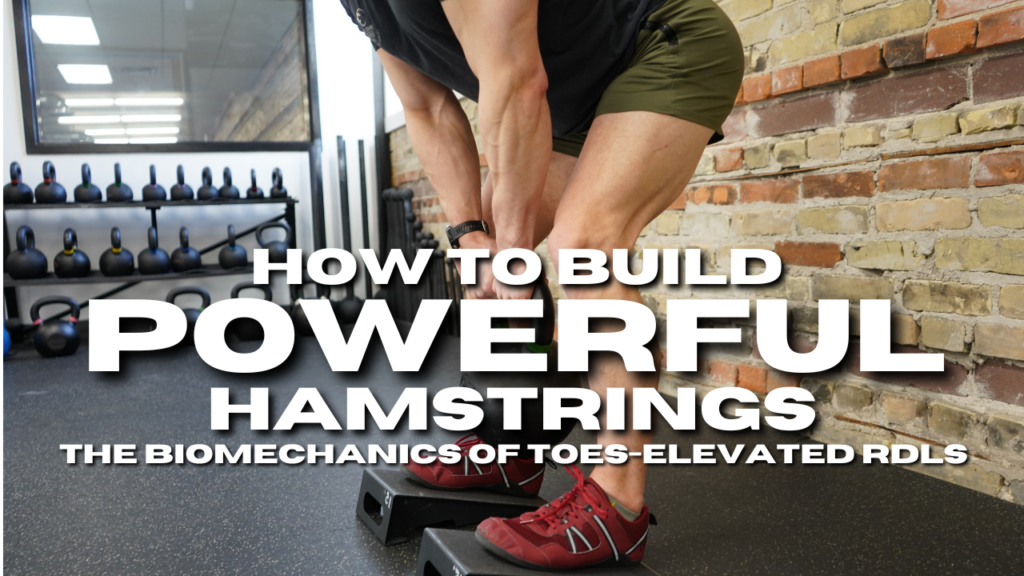
The Toes-Elevated Romanian Deadlift: Unlocking Superior Hamstring Engagement
When it comes to maximizing hamstring activation during Romanian deadlifts (RDLs), a simple yet effective tweak is elevating your toes. This small adjustment significantly alters muscle engagement, shifting the emphasis onto the hamstrings by increasing their range of motion and stretch. But why does this variation work so well, and how can you incorporate it effectively into your training? Let’s break it down.
Why Elevating Your Toes Enhances Hamstring Activation
In a conventional RDL, your feet remain flat on the ground, allowing for a balanced distribution of forces between your hamstrings, glutes, and stabilizing muscles like the calves. However, elevating your toes changes the mechanics of the movement in several key ways:
1. Increased Hamstring Stretch and Load
Elevating your toes increases ankle dorsiflexion, reducing calf involvement while lengthening the hamstrings at the hip joint. The result? A deeper stretch and greater tension on the hamstrings, particularly during the eccentric (lowering) phase. Studies have shown that eccentric loading is crucial for hypertrophy and strength development (Schoenfeld, 2020).
2. Improved Hip Hinge Mechanics
A toes-elevated stance encourages a more pronounced hip hinge by shifting your center of mass slightly backward. This adjustment minimizes excessive knee flexion—one of the most common mistakes in RDL execution—keeping the focus on hip extension, where the hamstrings and glutes are the primary drivers.
3. Reduced Quadriceps Involvement
Many lifters inadvertently turn RDLs into a squat-deadlift hybrid by incorporating too much knee bend. Elevating your toes helps minimize knee flexion, effectively decreasing quadriceps contribution and forcing the posterior chain (hamstrings, glutes, and adductors) to bear the majority of the load (Contreras, 2013).
4. Less Reliance on the Calves for Stability
While the calves play a minor role in stabilizing the lower body during RDLs, their function is reduced when the toes are elevated. This forces the hamstrings and glutes to assume greater responsibility for maintaining balance and control throughout the lift, increasing posterior chain activation (McGill, 2017).
Biomechanics: How It Works
Let’s analyze the biomechanics behind why this variation is so effective:
- Increased Ankle Dorsiflexion: Elevating your toes places the gastrocnemius (calf muscle) in a stretched position, reducing its ability to contribute to the movement.
- Enhanced Hamstring Length-Tension Relationship: Since the hamstrings cross both the hip and knee joints, they experience greater passive tension when stretched at the hip. The toes-elevated position amplifies this effect, leading to stronger contractions during the concentric phase.
- Posterior Chain Emphasis: With less knee flexion and reduced calf involvement, the hamstrings and glutes must work harder to stabilize and lift the weight, leading to increased muscle fiber recruitment.
How to Perform the Toes-Elevated RDL for Maximum Benefits
To execute this variation correctly, follow these key steps:
- Setup: Use a small squat wedge, weight plate, or slant board to elevate your toes about ½ to 1 inch off the ground.
- Stance: Stand with feet hip-width apart, holding a barbell, dumbbells, or kettlebell.
- Engage Your Core: Brace your core and engage your lats to maintain a neutral spine.
- Hinge at the Hips: Push your hips back while maintaining a slight bend in your knees.
- Lower the Weight: Slowly lower the weight until you feel a deep stretch in your hamstrings.
- Pause (Optional): Hold the bottom position for an added stretch and increased time under tension.
- Drive Through Your Heels: Engage your glutes and hamstrings to return to the starting position.
Recommended Sets & Reps:
- Strength Focus: 4–5 sets of 5–8 reps (heavy load)
- Hypertrophy Focus: 3–4 sets of 8–12 reps (moderate load)
- Mobility/Control Focus: 2–3 sets of 12–15 reps (lighter load, controlled tempo)
Why You Should Incorporate This Variation
The toes-elevated Romanian deadlift is a highly effective way to enhance hamstring development, improve flexibility, and reinforce proper hip hinge mechanics. Key benefits include:
✅ Increased passive tension and stretch on the hamstrings
✅ Minimized knee flexion, reducing quadriceps involvement
✅ Enhanced eccentric loading for better strength and mobility gains
✅ Greater neuromuscular engagement, leading to higher force output
If you struggle to feel your hamstrings working during RDLs or want to maximize posterior chain activation, this variation is worth adding to your training program.
Conclusion
The toes-elevated Romanian deadlift is more than just a minor tweak—it’s a biomechanical shift that significantly enhances hamstring activation, flexibility, and strength. By reducing calf stabilization, shifting the center of mass, and increasing eccentric load, this variation helps lifters achieve better results in both muscle development and movement mechanics. Try it in your next leg session and feel the difference firsthand!
References:
- Schoenfeld, B. J. (2020). Science and Development of Muscle Hypertrophy.
- Contreras, B. (2013). Strong Curves: A Woman’s Guide to Building a Better Butt and Body.
- McGill, S. (2017). Back Mechanic: The Step-by-Step McGill Method to Fix Back Pain.